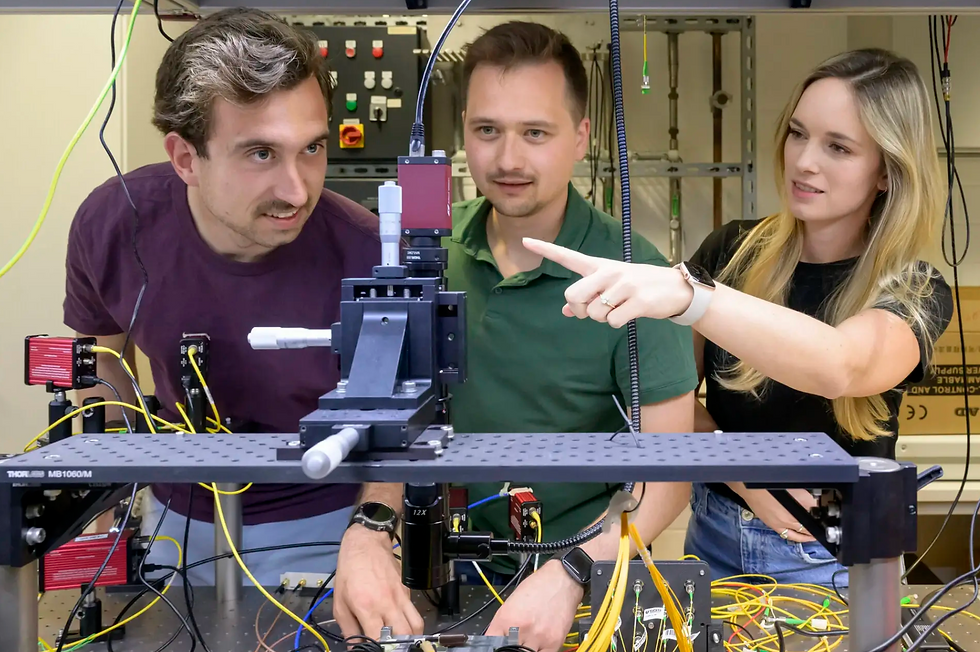Exploring Innovations in Quantum Photonics at SPIE Optics + Optoelectronics Conference in Prague
- Jade Robinson
- Apr 15
- 3 min read
Last week, the SPIE Optics + Optoelectronics Conference took place in the beautiful city of Prague. This event brought together experts and enthusiasts from optics and photonics for engaging discussions about light-based technologies. This annual gathering is not just another conference; it’s a vital hub where researchers and innovators come to exchange ideas on breakthroughs that can shape our future.
One of the major highlights was Julian Rasmus Bankwitz's presentation on his groundbreaking work with Photonic Integrated Circuits (PICs). These circuits are crucial for propelling advancements in quantum photonics and integrated technologies. Industries like telecommunications, healthcare, and computing rely on these innovations to improve their efficiency and performance.
The varied backgrounds of attendees opened the floor to discussions on a range of topics—including high-power lasers and next-generation photonic systems—things that could redefine technology as we know it.
The Importance of Photonic Integrated Circuits
Photonic Integrated Circuits (PICs) are gaining attention for improving the performance of optical systems. Unlike traditional electronic circuits, which use electrons for data transfer, PICs utilize photons. This shift can significantly boost data processing speeds. For example, studies show that systems employing PICs can offer data transmission speeds 10 times faster than conventional methods.
Julian’s research emphasized the exciting possibilities of combining PICs with quantum technologies. With the rapid growth of quantum computing, integrating these circuits could enable tasks that were once thought impossible. For instance, research indicates that using PICs in quantum systems could lead to a 30% increase in efficiency for processing quantum information.
As the community innovates, this work reflects broader trends towards hybrid systems that combine both classical and quantum technologies. The potential for real-world applications is enormous, providing exciting opportunities for sectors like clean energy and advanced telecommunications.
Engaging Dialogues and Networking Opportunities
Conferences like SPIE create unparalleled opportunities for networking and collaboration. Attendees engaged in spirited discussions about the latest advancements in their fields, sharing both successes and challenges. This exchange of ideas is essential for fostering innovation.
A key takeaway from the event was the collaborative spirit that characterizes the optics and photonics community. Professionals from academia and industry often discover that teamwork can lead to breakthroughs that individual efforts might miss. For instance, partnerships among universities, startups, and established companies can accelerate the development of new technologies.
The presence of industry leaders also provided valuable insights into market trends. The photonics market is growing, with projections showing a compound annual growth rate of 20% through 2026. Many companies are actively investing in research and development, enhancing their photonic solutions to meet rising demands for quicker and more efficient technologies.
Highlights from Presentations and Panels
A variety of illuminating presentations and discussions took place throughout the conference, showcasing the innovative nature of quantum optics and photonics. Attendees gained insights that included topics like non-linear optics and the role of artificial intelligence in photonics.
The energy in the room was contagious, with attendees actively engaging during Q&A sessions. This enthusiasm highlights the importance of creating platforms where diverse stakeholders can stay updated on emerging trends and research developments.
The exhibition area buzzed with activity, featuring cutting-edge products and technologies from various exhibitors. This offered attendees a unique chance to interact with new innovations that are set to transform the future of optics.
Looking Forward: The Future of Quantum Photonics
As the conference concluded, it became evident that the future of quantum photonics is bright. Discussions surrounding integrated technologies and high-power laser applications signal that significant advancements are on the horizon. Industries such as telecommunications and medical technology stand to benefit greatly.
The collaboration between academia and industry is crucial for addressing the complex challenges associated with technology integration. We are witnessing an era where optics, photonics, and quantum technologies can merge to create impactful solutions for pressing global issues.
The journey into this evolving frontier is filled with promise. Conferences like SPIE lay the groundwork for cooperative innovation, with the spirit of curiosity shared among attendees symbolizing the thriving nature of the photonics community.
A Bright Outlook for Collaboration
The SPIE Optics + Optoelectronics Conference in Prague was not merely a gathering but a celebration of innovation and collaboration. The insights shared by Julian Rasmus Bankwitz and others illuminated the path forward for researchers and industry players alike as they navigate the exciting world of quantum photonics.
Looking ahead, it is essential for the community to nurture these connections and support ongoing research initiatives. The future of photonics is bright, and Linq Photonics is eager to contribute to the journey ahead.
🔬 Curious about what we’re building at Linq? Reach out — we love talking deep tech.
Thank you for joining us on this exploration of innovations at the SPIE Optics + Optoelectronics Conference. We look forward to bringing you more insights and developments from the world of photonics.




